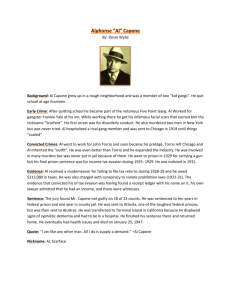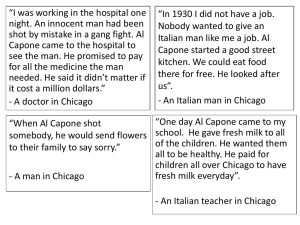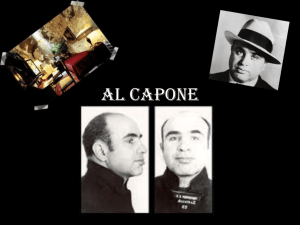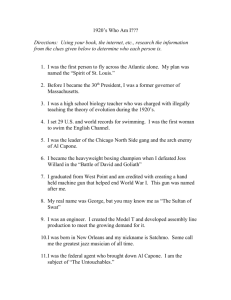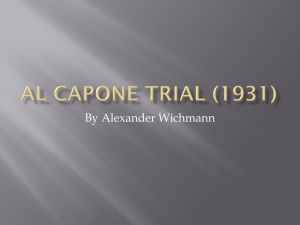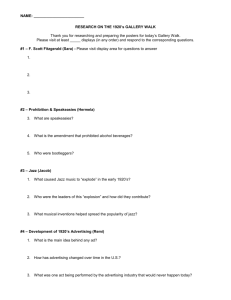MRN-EN-6-GSM part 1 - Home page docenti
advertisement
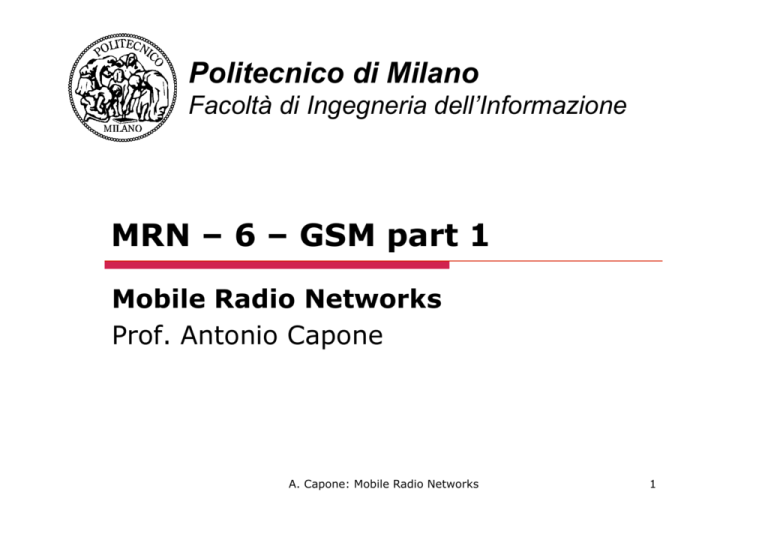
Politecnico di Milano Facoltà di Ingegneria dell’Informazione MRN – 6 – GSM part 1 Mobile Radio Networks Prof. Antonio Capone A. Capone: Mobile Radio Networks 1 General characteristics of the system A. Capone: Mobile Radio Networks 2 History (1) o 1982: the CEPT (Conférence Européenne des Administrations des Postes et des Télécommunications) creates special interest group for the definition of a pan-European cellular system: the Groupe Spécial Mobile, GSM o 1985: Definition of the list of recommendations (standard specifications) that the GSM will work on (they ended up to be about 130: 1500 pages in 12 volumes! ... plus all those of the evolution, phases 2+ and 3 of GSM) A. Capone: Mobile Radio Networks 3 History (2) o 1988: the ETSI (European Telecommunication Standards Institute) is created by the CEPT and the European Commission, and the GSM standardization activity is moved in the new organization o 1990: GSM specifications are extended to DCS1800 (Digital Cellular System on 1800 MHz), o 1992: The final version of the standard is released, with the new meaning of the acronym Global System for Mobile Communications o 1992: Commercial launch of GSM (initially planned for 1991 and then delayed because of the lack of mobile terminals) A. Capone: Mobile Radio Networks 4 History (3) o 1994-95: Introduction of the SMS o 1995-97: Commercial introduction of DCS1800 (operating at 1800 MHz) o 1996: Standardization of enhanced voice codecs o 1997: Dual-band terminals o 1999: Standardization of GPRS o 2000/01: Commercial introduction of GPRS A. Capone: Mobile Radio Networks 5 General characteristics o Second Generation Digital System (2G) o Multiple access scheme based on multicarrier TDMA o Fixed frequency reuse o Services n Telephony with supplementary services n Circuit data services (single channel and multiple channles) n Packet data (GPRS – General Packet Radio Service) A. Capone: Mobile Radio Networks 6 Frequencies GSM /900 DCS/1800 downlink uplink downlink uplink F[ MHz ] 915 880 890 125+49 carriers 935 925 960 125+49 carriers esteso uplink esteso downlink 1785 1805 1710 374 carriers 1880 374 carroers o In UK and USA different frequencies around 1900 MHz are used for DCS (1850÷1910 uplink, 1930÷1990 downlink). A. Capone: Mobile Radio Networks 7 Radio carriers o Radio carriers are spaced of 200 kHz 200 kHz f o On each carrier the transmission rate is 270.833 Kb/s o Carriers are identified by a ARFCN (Absolute Radio Frequency Channel Number) o Modulation GMSK (Gaussian Minimum Shift Keying) o Each pair of frequencies for uplink and downlink are spaced of 45 MHz in GSM 900 and 95 MHz in DCS 1800 A. Capone: Mobile Radio Networks 8 TDMA Frame o On each carrier the TDMA scheme allows to create up to 8 channels for the transmission of coded voice at 13 Kb/s TDM Frame - 4.615 ms 5 6 7 0 1 2 3 4 5 6 7 0 1 2 3 BTS Transmits fdown 2 3 4 5 6 7 0 1 2 3 4 5 6 7 0 MS Transmits f up Time slot = 577 µs A. Capone: Mobile Radio Networks 9 Other characteristics o Power Control n Power emitted by base station and mobile terminals is regulated with a closed loop control o Discontinuous Transmission n During voice breaks, coding is paused for reducing interference and energy consumption A. Capone: Mobile Radio Networks 10 System Architecture A. Capone: Mobile Radio Networks 11 Network architecture Um NSS BSC VLR Um BTS Network Switching Subsystem HLR A AuC Abis Um Abis Um BSC EIR A BTS GMSC Abis BSC A E OMC Abis BTS BTS Radio BSS OMSS Operation and Maintenence Subsystem MSC VLR A RS Fixed Telephone Network ISDN/PSTN BSC Base Station Subsystem A. Capone: Mobile Radio Networks 12 Mobile Station (MS) o Three categories with different nominal power: n vehicular: up to 20 W n portable: up to 8 W n personal (hand-terminal): up to 2 W (the only category currently used) Classe 1 2 3 4 5 Potenza massima nominale [W] GSM 900 MHz DCS 1800 MHz . 1 8 0,25 5 4 2 . 0,8 . A. Capone: Mobile Radio Networks Potenza media nominale [mW] GSM 900 MHz DCS 1800 MHz . 120 960 30 600 480 240 . 96 . 13 Mobile Station (MS) o Characteristics n MS multi-band: can operate in different bands (900, 1800, 1900, …) n MS multi-slot: can operate activating multiple slots simultaneously (GPRS only) o MS includes ME (Mobile Equipment) and SIM (Subscriber Identity Module) n ME is the main part of the mobile terminal which includes all hw and sw modules. Identified by an IMEI (International Mobile Equipment Identifier) n SIM include the functions for identifying the user and executing security procedures A. Capone: Mobile Radio Networks 14 Subscriber Identity Module (SIM) o It’s a smart card (with micro processor and memory) which is essential to activate any ME o Multi be inserted in the reader slot of the ME o Serial number n Identify the SIM card o International Mobile Subscriber Identity (IMSI) n Identify the user in the network o Security authentication and cyphering information n A3 and A8 algorithm (used for authentication and cyphering) n Ki, Kc (authentication and cyphering keys) A. Capone: Mobile Radio Networks 15 Subscriber Identity Module (SIM) o Temporary Network information n LAI (Location Area Identifier), last visited location area n TMSI (Temporary Mobile Subscriber Identity), temporary identifier used on behalf of the IMSI o Subscribed services o Personal Identity Number (PIN) o Personal Unblocking Number (PUK) o Access rights o Prohibited networks o Call messages o Phone numbers A. Capone: Mobile Radio Networks 16 Base Station System (BSS) o The BSS includes the functional units that deal with the radio access n Radio coverage and communication with the MSs through the radio interface n Radio resource management o The BSS includes: n Base Transceiver Station (BTS) o Implements the low level protocols of the radio interfaces. It executes control commands sent by the BSC n Base Station Controller (BSC) o Implements high level protocols controlling a group of BTSs. Receive information on radio interfance status from BTS and issues configuration and management commands A. Capone: Mobile Radio Networks 17 Network Switching Subsystem (NSS) o The NSS is the circuit switching network of the mobile system o It is used for circuit based services only (voice) o It is basically a telephone network with additional functionalities, nodes and databases for managing mobile users A. Capone: Mobile Radio Networks 18 Network Switching Subsystem (NSS) o the NSS includes: n Mobile Switching Center (MSC): o Telephone switching station for mobile systems n Visitor Location Register (VLR): o It’s a database (usually integrated into the MSC) including temporary information on users visiting the MSC area n Home Location Register (HLR): o It’s the main database of the network that includes all information on mobile users. Includes also the information on the currently visited VLR n Authentication Center (AuC): o Usually associated with the HLR. It is in charge of authentication functions n Equipment Identity Register (EIR): o Include the IMEI of authorized devices A. Capone: Mobile Radio Networks 19 Operation and Maintenence Subsystem (OMSS) o The OMSS includes the units in charge of controlling and monitoring network elements by remote o The OMSS can n configure the functionalities of all network devices n Visualize alarms on failures and anomalous behavior n Visualize traffic statistical data n etc. A. Capone: Mobile Radio Networks 20 Areas defined in GSM o PLMN (Public Land Mobile Network) Area: n Service area of an operator o MSC/VLR Area: n Area managed by a MSC. Data of users in this area are stored in the VLR associated with the MSC o Location Area: n A MSC/VLR area includes one or more Location Areas (LA). LA is identified by a LAI (Location Area Identifier), transmitted by all BTSs in the area on the broadcast channel o Cell: n area covered by a BTS. Identified by a BSIC (Base Station Identity Code), transmitted on the broadcast channel A. Capone: Mobile Radio Networks 21 Base Transceiver Station (BTS) o The BTS is in charge of implementing the low level protocols of the radio interface o It transmits and receives signals from the MSs implementing modulation, coding and multiplexing functions on physical channels o It has the task of performing quality measurements on physical channels and to collect those performed by MSs (all measurements are reported to the BSC) o It interfaces with the BSC with PCM channels at 64 kbit/s o Connects PCM channels with those of the radio interface (traffic and signaling) A. Capone: Mobile Radio Networks 22 Transcoder Rate Adaptation Unit (TRAU) o GSM voice coding is at 13 Kbit/s while PCM is at 64 Kbit/s o The transcoding is performed by the TRAU o The TRAU can be in the BTS, or (more often) in the BSC o In this last case 13 Kbit/s flows must be transmitted over 64 Kbit/s channels o On each 64 Kbit/s 4 flows at 13 Kbit/s are multiplexed (they are first transformed into 16 Kbit/s flows with some padding) o For each GSM carrier (8 channels at 13 Kbit/s) 3 PCM channels at 64 Kbit/s are necessary n One for the signaling transported with the link protocol LAPD n 2 for the 8 traffic channels A. Capone: Mobile Radio Networks 23 Transcoder Rate Adaptation Unit (TRAU) signaling Frame delimiter channel 1 2 30 31 0 1 2 … 15 16 15 16 17 … 29 30 30 31 0 1 125 µs PCM channels (64 Kbit/s) GSM channels (13 kbit/s) PCM channels (64 kbit/s) TRAU MSC BSC 1 PCM channel per voice circuit A. Capone: Mobile Radio Networks BTS 1 PCM channel for 4 voice circuits 24 BTS structure o BTS is usually divided into n TRX (Transceiver) o Radio elements for transmission and reception on a single radio carrier n BCF (Base Common Function) o Control element of a set of TRX that also control connection interface with the BSC A. Capone: Mobile Radio Networks 25 BTS structure one TX antenna Combiner two RX antennas Splitter …. …. TX RX Signal Processing TRX Controller TRX TX RX Signal Processing TRX Controller TRX …………….... A-bis Interface PCM line or Radio system 2 Mb/s BSC A. Capone: Mobile Radio Networks 26 Base Station Controller (BSC) o A BSC controls a large number of BTSs: from a few tens to hundreds o Main BSC tasks include: n Cell configuration with assignment of traffic and control channels n Setup and release of channels at A and Abis interfaces n Handover management n Paging management n Analysis of measurements received by BTSs and MSs for the handover activation A. Capone: Mobile Radio Networks 27 Base Station Controller (BSC) o BSC is in charge of the Radio Resource Management (RRM) o It is also a switching node n Even if it does not implement routing (this is done by the MSC) n It connects BTS circuits with MSC circuits performing (often) the trans-coding (TRAU) n It switches circuits during handover (intraBSC) o The BSCs can be co-located with the MSC, or located in different sites A. Capone: Mobile Radio Networks 28 Mobile Switching Centre (MSC) o The MSC is the telephone switching station of the mobile radio network and it has additional functionalities for mobility management o It is associated with a VLR for storing information on visiting users o The MSC is connected to its BSCs and other MSC in the network n PCM channels (multiplexed with PDH or SDH) are used for the connection n Some of the resources are used for the signaling network SS7 o One or more MSC (called Gateway MSC) per PLMN are connected to the external telephone networks A. Capone: Mobile Radio Networks 29 Mobile Switching Centre (MSC) o A MS can be reached by fixed telephone lines through the number MSISDN o The call is routed to the GMSC which identifies the HLR, retrieves from it user information through the MSISDN o The HLR provides the MSRN (Mobile Station Roaming Number) n MSRN is a temporary telephone number (same structure of the MSISDN) assigned by the visited VLR n MSRN allows the GMSC to route call to the MSC currently visited by the user A. Capone: Mobile Radio Networks 30 Mobile Switching Centre (MSC) o The MSC is the main element of the signaling network (we’ll see signaling later on) o The MSC implements the functions n CM (Connection Management) o originating call, terminating call, gateway n MM (Mobility Management) o location updating, periodic registration, authentication, … o Signaling protocol for communication with other network elements: n DTAP (Direct Transfer Application Part) for direct communication with MS n BSSMAP (BSS Management Application Part) for communication with BSC n MAP (Mobile Application Part) for communication with other MSC, VLR, HLR, EIR, AuC A. Capone: Mobile Radio Networks 31 Home Location Register (HLR) HLR o It is a database permanently associated with a GMSC o It stores data on all MSs associated with GMSC (through the MSISDN) o The HLR stores permanent information like IMSI MSISDN, registered services, etc. o The HLR also stores temporary information like the currently visited VLR address, authentication and encryption temporary keys, etc. A. Capone: Mobile Radio Networks 32 Visitor Location Register (VLR) VLR o It’s a database for storing temporary information on users in the area of a MSC o In the VLR all relevant data of visiting users are duplicated from the HLR o The IMSI is mapped into a TMSI (Temporary Mobile Subscriber Identity) for avoiding transmitting it in clear text over the air interface A. Capone: Mobile Radio Networks 33 Security procedures o Authentication: n It is in charge of verifying user identity and protect the system from non authorized access o Encryption: n It is in charge of coding the flow of data so that it cannot decoded by others o In GSM authentication and encryption are strongly related for the key management A. Capone: Mobile Radio Networks 34 Security procedures o Ingredients: n Ki o Authentication key of 128 bits stored in the AuC and in the SIM n RAND o Random number of 128 bist generated by the AuC and then sent to the MSC n A3 o Algorithm for the authentication stored in the AuC and the SIM n A8 o Algorithm for generating the encryption key Kc, stored in the AuC and the SIM Procedure results: Multiple Triples Kc encryption key (RAND, SRES, Kc) SRES result of the Are generated for each IMSI authentication algorithm and stored in the HLR A. Capone: Mobile Radio Networks 35 Security procedures o Authentication: MS Ki Network RAND Ki A3 RAND Random number generator A3 SRES(network) SRES(ms) Yes Access granted A. Capone: Mobile Radio Networks equal? No Access denied 36 Security procedures o Encryption: Network MS Ki Ki RAND A8 A8 Kc A5 RAND Random number generator Kc informazioni cifrate A. Capone: Mobile Radio Networks A5 37 Security procedures: Roles of network elements o Authentication Centre (AuC) AuC n It stores secret keys Ki of all users n Generated random numbers and calculates SRES and encryption keys Kc n Provides triples to the other network elements richiesta (TMSI) MS RAND SRES A. Capone: Mobile Radio Networks MSC/VLR VLR IMSI triplette IMSI HLR AuC triplette RAND, SRES, Ki 38 Security procedures: Roles of network elements o Role of the BSS in the encryption: MS Ki A8 MSC/VLR request RAND SRES BSS Kc A5 Encrypted text A. Capone: Mobile Radio Networks A5 Kc VLR Clear text 39 Security procedures: TMSI allocation o All communications are initiate by the MS that transmits its ID (IMSI) for activating the authentication procedure o For avoiding transmitting the IMSI in clear over the air interface the VLR allocates to each MS a TMSI (Temporary Mobile Subscriber Identity) o The IMSI is used only when a TMSI is not available o At each location update the VLR can allocate a new TMSI to MS A. Capone: Mobile Radio Networks 40 IMSI o It’s the internal user identification number o It is composed of three fields: n MCC: Mobile Country Code (3 digits) n MNC: Mobile Network Code (2 digits) n MSIC: Mobile Subscriber Identification Number (up to 10 digits) o For example 222 01 4572228769, identifies an Italian SIM (222) of the TIM mobile operator (01) o The telephone number (MSISDN) is completely independent from the IMSI A. Capone: Mobile Radio Networks 41 Equipment Identity Register (EIR) EIR o It is an optional network database o It includes the ID (IMEI) and the characteristics of all mobile equipments (manufacturer, country, etc.) o It can be used for preventing the use of stolen devises MS Conn. request MSC/VLR IMEI request IMEI reply IMEI check EIR reply A. Capone: Mobile Radio Networks 42 Operation and Maintenance Subsystem (OMSS) o It is the system in charge of all management and monitoring functions (both technical and administrative) of the network o It performs billing, traffic control, alarm messages management, BTS and BSC monitoring, configuration, etc. o It allows to configure by remote all network elements and to check their correct operation A. Capone: Mobile Radio Networks 43 Operation and Maintenance Subsystem (OMSS) o It is based on a hierarchical architecture n OMC (Operation & Maintenance Centre) regional n NMC (Network Management Centre) NMC OMC OMC HLR HLR EIR MSC MSC BSC A. Capone: Mobile Radio Networks BSC BSC EIR BSC 44 Radio Interface A. Capone: Mobile Radio Networks 45 Radio interface FDD (Frequency Division Duplexing) 45 MHz di separazione uplink/downlink downlink uplink f 200 kHz 915 880 890 6 7 0 1 2 3 4 5 6 7 0 960 925 TDM Frame - 4.615 ms 5 935 1 2 3 BTS Transmits fdown 3 slot offset uplink/downlink 2 3 4 5 6 7 0 1 2 3 4 5 6 7 0 MS Transmits f up Time slot = 577 µs A. Capone: Mobile Radio Networks 46 Radio interface o Modulation: n MGSK (Minimum Gaussian Shift Keying) o Phase continuous modulation with Gaussian pulse (intersymbol interference) o Channel coding: n Convolutional o With several different rates o Equalization: n Known bit sequences transmitted in each physical burst n Equalization filter synthetized at the receiver o Voice coding: n 13 Kbit/s (RPE codec - full rate) n 12.2 Kbit/s (CELP codec - enhanced full rate) A. Capone: Mobile Radio Networks 47 Transmission and reception Voice 13 Kb/s 22.8 Kb/s Channel coding Source coding 22.8 kb/s Timing Modulation GMSK 32 kb/s Control Voice Decoder Channel Decoder Equalizator A/D Converter Demodulator o From 13 Kbit/s of the codec we get to 32 Kbit/s on the radio channel A. Capone: Mobile Radio Networks 48 Frequency Hopping o The impact of multipath fading depends on the signal frequency o There may be carriers with low attenuation and carriers with high attenuation f o Since transmission are protected by FEC coding, it is more convenient to spread errors o GSM uses a frequency hopping mechanism that changes frequency slot by slot A. Capone: Mobile Radio Networks 49 Power Control o MS power is controlled by the BTS, and BTS power (traffic carriers only) is controlled by the MS o The power control mechanism is based on a closed loop scheme with up/down commands send in both directions o The power control step is 2 dB o The objective is keeping received power constant o The power control reduces interference and energy consumed by MSs A. Capone: Mobile Radio Networks 50 Synchronization o Carrier synchronization n Frequency synchronization o Slot synchronization n Time slot synchronization o Frame synchronization n Frame number o Base station synchronization (optional) n Slots and frame A. Capone: Mobile Radio Networks 51 Carrier synchronization o The carrier frequency synchronization is achieved by the MS listening on the broadcast channel transmitted by the BTS o On this channel, at periodic intervals, the BTS transmit a special slot in which a known sequence is transmitted o This is used by the MS to adjust the local frequency A. Capone: Mobile Radio Networks 52 Slot and Frame synchronization o GSM channels are based on a multi-frame scheme (for instance, the broadcast channel is transmitted only in some frames of the multiframe) o Also the Frequency Hopping sequence depends on the multi-frame o All MSs must know the frame number in the multi-frame to decode the TDMA channels correctly o The BTS transmits on the broadcast channel some information that allows MSs to obtain the slot synchronization and the Frame Number A. Capone: Mobile Radio Networks 53 Timing advance o The TDMA transmissions require guard times due to propagation delays 2τ Time Reference Propagation delay τ=dv d - distance v – light speed Tg = max(2τ i ) i A. Capone: Mobile Radio Networks 54 Timing advance o GSM is designed for cells with a radius of up to Rmax=37.8 Km o The guard time should then be 2τ = 2 x 108 = 233 µs x 35 / 3 o Which is equivalent to 68,25 bits at carrier rate of 270.8 Kb/s A. Capone: Mobile Radio Networks 55 Timing advance o For reducing the guard time the BTS estimates the delay and send it to the MS on a control channel. o The MS can then compensate the delay and reduce guard time o Guard time of normal slots in GSM is 8.25 bits (30.46 µsec) 2) Delay 4) Other Transmissions estimation 1) First Transmission 3) Timing Advance command A. Capone: Mobile Radio Networks 56 Physical block (Burst) o The burst is the physical layer PDU transmitted in a time slot o Due to TDMA scheme each burst is an autonomous transmission with its own power profile dB +4 +1 -1 -6 -30 -70 10 8 10 A. Capone: Mobile Radio Networks 542.8 10 8 10 µs 57 Bursts o Normal Burst n o Used for data transmission in traffic channels Access Burst n Used for the first access on the Random Access Channel (RACH) n It has a long guard time since the timing advance mechanism is still not active A. Capone: Mobile Radio Networks 58 Bursts o Frequency Correction Burst n Used for frequency synchronization on the Frequency Correction Channel (FCCH) - 142 bits all set to “1” o Synchronization Burst n Used for transmitting the slot and frame synchronization information o Dummy Burst n Padding burst n Used in downlink only for ensuring a constant power profile to broadcast carrier A. Capone: Mobile Radio Networks 59 Normal Burst 148 bit = 546.12 µs T 3 • • • • • Coded bits 57 Training S Sequence S 1 1 26 Coded bits 57 Guard T Period 3 8.25 577 µs T-bits: set to 0, used as frame delimiters S-bits: (stealing bits) indicate is the burst has user data or signaling Coded Data: user data (voice, data, etc.), 114 bits Training Sequence: control bits for the channel equalization GP: Guard time A. Capone: Mobile Radio Networks 60 Access Burst T 8 Synchronisation 41 Coded bits 36 T 3 Guard Period 68.25 577 µs o First transmission in uplink o It has 156.25 bits n 8 tailing bits n 41 synchronization sequence n 36 coded bits n 3 tailing bits n 68.25 bits of guard time A. Capone: Mobile Radio Networks 61 Frequency Correction Burst T 3 Fixed bit sequences 142 Guard T Period 3 8.25 577 µs o It includes 148 + 8.25 bits n 2 x 3 tail control bits n 142 fixed bit sequences o All set to 0 o They allows frequency synchronization n 8,25 bits of guard period A. Capone: Mobile Radio Networks 62 Synchronization Burst T 3 Coded bits 39 Training sequence 64 Coded bits 39 Guard T Period 3 8.25 577 µs o It includes 148 + 8.25 bits n 2 x 3 tail control bits n 2 x 39 coded bits o 25 bits of information o that become are 78 coded bits o Divided into to fields of 39 bits each n 64 bits of training sequence n 8.25 bits of guard period A. Capone: Mobile Radio Networks 63 Dummy Burst T 3 Pseudo-random sequence 142 Guard T Period 3 8.25 577 µs o Used in downlink on the carrier where the control channels are allocated o It ensures that power profile is constant o Power control is not used on this carrier o It includes 148 + 8.25 bits n 2 x 3 tail control bits n 142 pseudo-random sequence n 8.25 bits of guard period A. Capone: Mobile Radio Networks 64 Logical channels o “Logical channels” in GSM identify different types of information transmitted over the air interface: n Signaling n Traffic data o They are divided into: n Traffic channels and control channels n Common channels and dedicated channels A. Capone: Mobile Radio Networks 65 Logical channels LOGICAL CHANNELS COMMON CHANNELS Broadcast CONTROL CHANNELS FCCH SCH DEDICATED CHANNELS Common CONTROL CHANNELS BCCH PCH RACH Dedicated CONTROL CHANNELS AGCH FCCH=Frequency Correction CHannel SCH=Synchronisation Channel BCCH=Broadcast Control CHannel PCH=Paging CHannel RACH=Random Access CHannel AGCH=Access Grant CHannel A. Capone: Mobile Radio Networks SDCCH SACCH TRAFFIC CHANNELS FACCH TCH/F TCH/H TCH/E SDCCH=Stand-alone Dedicated Control CHannel SACCH=Slow Associated Control CHannel FACCH=Fast Associated Control CHannel TCH/F=Traffic CHannel Full rate TCH/H=Traffic CHannel Half rate TCH/ E=Traffic CHannel Enhanced Full rate 66 Traffic Channels (TCH) o Channels transporting user data (voice or data) o They can be: n Full Rate channels: 22,8 Kb/s n Half Rate channels: 11,4 Kb/s trama 1 Full Rate Half Rate Tf trama 2 Tf Tf t Th Th Th Th t slot A. Capone: Mobile Radio Networks 67 Control Channels (CCH) o Used for transporting signaling of different types (14 types of control channels) o Three categories of CCHs n Broadcast Channels (BCH): system information transmitted in the downlink n Common Control Channels (CCCH): shared channels for connection initialization n Dedicated Control Channels (DCCH): signaling channels dedicated to specific traffic connections Broadcast CONTROL CHANNELS FCCH SCH Common CONTROL CHANNELS BCCH A. Capone: Mobile Radio Networks PCH RACH Dedicated CONTROL CHANNELS AGCH SDCCH SACCH FACCH 68 Broadcast Channels (BCH) Broadcast CONTROL CHANNELS o FCCH (Frequency Correction Channel): Channel for frequency synchronization (frequency correction bursts only) o SCH (Synchronization Channel): it includes BTS id (BSIC) frame number (FN) o BCCH (Broadcast Control Channel): General system information A. Capone: Mobile Radio Networks 69 BCCH (Broadcast Control Channel) Broadcast CONTROL CHANNELS o Number of common control channels (2 bits) o 1 bit for the common control TDMA scheme type o Number of block reserved to AGCH (3 bits) o Periodicity of paging di messages (3 bits) o Frequency Hopping parameters A. Capone: Mobile Radio Networks 70 Common Control Channels (CCCH) Common CONTROL CHANNELS o PCH (Paging Channel): downlink used by the BTS per informing MSs of incoming calls, broadcasted over the LA o RACH (Random Access Channel): uplink used by MSs for accessing the network (new calls, location update, etc.). It’s contention based. o AGCH (Access Grant Channel): downlink, used for replies to RACH requests A. Capone: Mobile Radio Networks 71 Dedicated Control Channels (DCCH) Dedicated CONTROL CHANNELS o SACCH (Slow Associated Control Channel): exchange of measurements during connection between MS and BTS (signal strengths, quality, ….). Multiplexed with the traffic channel (184 bits every 20 ms of measurements) o FACCH (Fast Associated Control Channel): used for signaling during handover. It partially replaces traffic channel in the TDMA structure. o SDCCH (Stand-alone Dedicated Channel): Signaling channel assigned in the first phase of call setup after the RACH/AGCH message exchange (identification, authentication, call set-up, …) A. Capone: Mobile Radio Networks 72 Slow Associated Control Channel (SACCH) Dedicated CONTROL CHANNELS o In downlink: n Power control commands n The same BCCH info (they cannot be decoded by the MS because it is listening on the traffic channel) n BCCH-FREQ-NCELL “N” (# carriers of BCCH of neighboring cells) n BSIC-NCELL “N” (BSIC of neighboring cells) o In uplink: measurements from the MS: n RXLEV-SERVING-CELL (signal strength from the serving BTS) n RXQUAL-SERVING-CELL (BER measured on the downlink) n RXLEV-NCELL “N” (signal strength from neighboring cells) A. Capone: Mobile Radio Networks 73 Connection setup MS BS BCCH Broadcast info RACH Access request AGCH SDCCH assignment SDCCH TCH + SACCH A. Capone: Mobile Radio Networks Signaling traffic + TCH assignment traffic + signaling 74 Random Access (RACH) o On the RACH a random access scheme is used o Collisions can occur o The correct reception of the access request is acknowledged with a reply message on the AGCH o In the RACH a temporary random identifier is included which is also reported in the AGCH reply o The RACH access protocol is a simple SlottedALOHA A. Capone: Mobile Radio Networks 75 Mapping of logical channel into physical channels o For using different rates for different logical channels the mapping into physical channels (TDMA structure) is based on a multi-frame Frame 1 0 1 2 Frame 2 31 32 33 34 63 64 65 66 0 1 2 Multi-Frame A. Capone: Mobile Radio Networks 76 Example: SACCH o A normal burst has 114 bits of data 148 bit = 546.12 µs T 3 Coded bits 57 Training S Sequence S 1 1 26 Coded bits 57 Guard T Period 3 8.25 577 µs o Using one slot per frame we have 114 [bits]/ 4.6 [ms]=24.7 Kb/s o The rate of coded voice is however 22,8 Kb/s o We have additional 1,9 Kb/s equivalent to 1 SLOT every 13 frames o SACCH: 1 SLOT every 26 frames for a speed of 950 bits/sec. A. Capone: Mobile Radio Networks 77 TCH+SACCH 0 12 25 T T T T T T T T T T T T AT T T T T T T T T T T T - o Traffic CHannels (T) and Slow Associated Control Channel (SACCH) (A) are multiplexed together o In a multi-frame of 26 frames (120 ms) A. Capone: Mobile Radio Networks 78 TCH+SACCH Downlink, Uplink T C H / F R T C H / F R T C H / F R T C H / F R T C H / F R T C H / F R T C H / F R T C H / F R T C H / F R T C H / F R T C H / F R T C H / F R S A C C H T C H / F R T C H / F R T C H / F R T C H / F R T C H / F R T C H / F R T C H / F R T C H / F R T C H / F R T C H / F R T C H / F R T C H / F R I D L E 0 1 2 3 4 5 6 7 8 9 10 1112 131415 1617181920 2122 2324 25 0 1 2 3 4 5 6 7 Normal Normal Normal Normal Normal Normal Normal Normal burst burst burst burst burst burst burst burst 577 µs 4,615 ms A. Capone: Mobile Radio Networks 79 Common control channels o One slot (slot 0) an a carrier (carrier 0) is assigned to common control channels with a multi-frame of 51 frames (235.38 ms) trama 0 7 0 1 2 trama 2 7 0 1 2 trama 50 7 0 1 2 7 0 1 2 supertrama A. Capone: Mobile Radio Networks 80 Common control channels o In the downlink • • • • FCH SCH BCCH CCH 0 FS o 50 frame. B C FS B C FS B C - In the uplink Random Access Channel (RACH) RRRRRRRRRRRRRRRRRRRR A. Capone: Mobile Radio Networks RRRRRRRRRR 81 SDCCH o Another slot is used for creating 8 Stand-Alone Dedicated Control Channel (SDCCH) (S) channels o Used for call setup and other signaling (LA, SMS) o The 8 channels are assigned 3 slots each in a 26 frames multi-frame 0 12 25 SSSSSSSSSSSSASSSSSSSSSSSS - A. Capone: Mobile Radio Networks 82 Voice coding: 13 Kb/s o Every 20 ms codec generates 260 bits that are divided into 3 groups (class 1a – 50 bits, class 1b - 132 bits, class 2 – 78 bits) Class 1a 50 bit Class 1b 132 bit Class 2 78 bit Cyclic code (53, 50) Class 1a 53 bit Class 1b 132 bit Tail 4 bit Class 2 78 bit Convolutional code 1/2 Class 1a + Class 1b 378 bit Class 2 78 bit 456 bit 456 bits in 20 ms equivalent to a rate of 22.8 Kb/s A. Capone: Mobile Radio Networks 83 Voice coding: 13 Kb/s 20 ms coded voice 456 bit Fragment 1 Fragment 2 Fragment 3 Fragment 4 114 bit 114 bit 114 bit 114 bit T 3 Coded bits 57 Training S Sequence S 1 1 26 Coded bits 57 T 3 Normal Burst o 4 Normal Burst transmitted into 4 frames 4.6*4 = 18.4 ms o But one every 13 is for signaling therefore on average 18.4*13/12=20 ms A. Capone: Mobile Radio Networks 84 Voice coding: 13 Kb/s o Interleaving: 4 blocks of 114 bits B(i,1) B(i,2) B(i,3) B(i,4) B(i+1,1) B(i+1,2) B(i+1,3) B(i+1,4) ... B(i+3,3) B(i+3,4) Interleaving B(i,1) B(i+1,1) B(i+2,1) B(i+3,1) B(i,2) A. Capone: Mobile Radio Networks B(i+1,2) B(i+2,2) B(i+3,2) ... B(i,4) B(i+1,4) B(i+2,4) B(i+3,4) 85 Data channel coding: 9.6 Kb/s 12 48 bit 60 bit 60 bit 60 bit 60 bit Tail 4 bit 240 bit codice convoluzionale 1/2 488 bit puncturing di 32 bit 456 bit A. Capone: Mobile Radio Networks 86 Signaling coding: SDCCH, BCCH, PCH, AGCH 184 bit codice FIRE (224, 184) 184 bit 40 bit Tail 4 bit codice convoluzionale 1/2 456 bit A. Capone: Mobile Radio Networks 87
